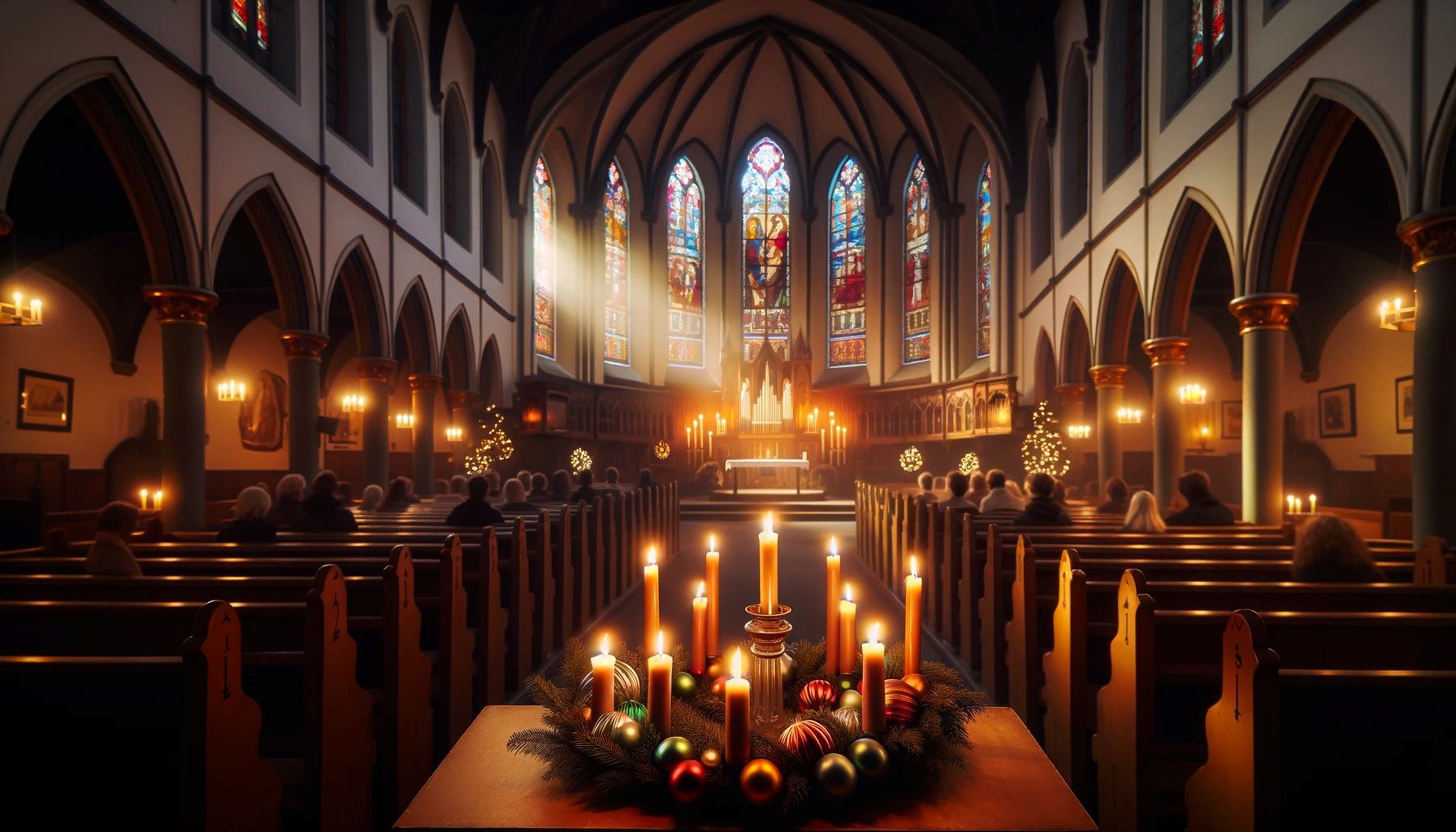Home>Special Themes>What Is Advent At Christmas


Special Themes
What Is Advent At Christmas
Published: February 13, 2024
Ericka Andersen, an editor at Christian.net, expertly merges digital strategy with content creation, focusing on faith and societal issues. Her communication skills enhance the platform's engaging narratives, fostering meaningful dialogue on belief's impact on society.
Discover the significance of Advent at Christmas and explore special themes that make this season unique. Learn about the traditions and customs associated with this special time of year.
(Many of the links in this article redirect to a specific reviewed product. Your purchase of these products through affiliate links helps to generate commission for Christian.net, at no extra cost. Learn more)
Table of Contents
Introduction
Advent is a cherished time of anticipation and preparation leading up to the joyous celebration of Christmas. It marks the beginning of the liturgical year in the Christian calendar and is observed with great reverence and excitement by millions of people around the world. This period, typically spanning four weeks, is a time of reflection, hope, and spiritual readiness as believers prepare their hearts to commemorate the birth of Jesus Christ.
During Advent, the faithful engage in various customs and traditions that hold deep symbolic significance, fostering a sense of unity and spiritual connectedness within the community. The rich history and profound meaning behind Advent make it a time of profound significance for Christians, serving as a poignant reminder of the profound love and grace embodied by the Christmas season.
As we delve into the history, traditions, and spiritual significance of Advent, we will uncover the profound beauty and depth of this sacred season, shedding light on the timeless customs and symbols that continue to enrich the hearts and souls of believers worldwide.
Read more: What Is The Meaning Of Advent Christmas
The History of Advent
The history of Advent can be traced back to the early centuries of Christianity, with its origins rooted in the practices of the Western Church. The word "Advent" is derived from the Latin word "adventus," meaning "coming" or "arrival," signifying the anticipation of the arrival of Jesus Christ. While the exact date of the inception of Advent remains uncertain, it is believed to have emerged in the 4th or 5th century as a period of spiritual preparation leading up to the celebration of the Nativity.
Initially, Advent was observed as a time of fasting and penitence, akin to the solemnity of Lent. The duration of Advent varied, with practices differing among regions and communities. Over time, the observance of Advent evolved to encompass a broader focus on spiritual reflection, joyful expectation, and the anticipation of the birth of Christ.
The liturgical color associated with Advent, purple, symbolizes penance, preparation, and royalty, reflecting the dual nature of the season as a time of solemn introspection and joyful anticipation. In some traditions, a rose-colored candle is lit on the third Sunday of Advent, known as Gaudete Sunday, symbolizing the joy and anticipation of the imminent celebration of Christ's birth.
The introduction of Advent wreaths, adorned with candles, further enriched the symbolism and rituals associated with the season. The wreath, typically featuring four candles, one for each week of Advent, serves as a visual representation of the passage of time and the increasing anticipation of the coming of Christ.
In the 6th century, the length of Advent was officially set to four weeks, establishing a structured framework for the observance of this sacred season. The themes of hope, love, joy, and peace became integral to the liturgical readings and observances during each week of Advent, providing a spiritual roadmap for believers as they journeyed towards the celebration of Christmas.
Throughout history, the observance of Advent has continued to evolve, incorporating diverse cultural and regional traditions while remaining steadfast in its core purpose of preparing hearts and minds to welcome the birth of Jesus Christ. Today, the rich historical tapestry of Advent serves as a testament to the enduring significance of this sacred season, uniting believers across generations in a shared journey of faith and anticipation.
Advent Traditions and Symbols
Advent is adorned with a tapestry of traditions and symbols that infuse the season with profound meaning and spiritual significance. These timeless customs serve as poignant reminders of the anticipation and preparation inherent in the Advent journey, fostering a sense of unity and reverence within the Christian community.
Advent Wreath:
Central to the observance of Advent is the iconic Advent wreath, a circular arrangement of evergreen foliage adorned with four candles, typically three purple and one rose. Each candle represents a week of the Advent season, with the lighting of a new candle symbolizing the progression of time and the increasing anticipation of the arrival of Christ. The vibrant greenery of the wreath signifies eternal life and the unending love of God, while the candles illuminate the path towards the celebration of the Nativity.
Advent Calendar:
The Advent calendar, a beloved tradition in many households, serves as a delightful countdown to Christmas. Originating in 19th century Germany, the Advent calendar features 24 doors or compartments, each concealing a small treat or symbol. As each day of Advent unfolds, children and adults alike eagerly open a new door, savoring the anticipation and joy of the approaching Christmas festivities.
Read more: How Does Advent Prepare Us For Christmas
Nativity Scenes:
Nativity scenes, or creches, hold a cherished place in Advent traditions, depicting the humble manger scene of the birth of Jesus. These intricate displays, often featuring handcrafted figurines of the Holy Family, shepherds, and animals, serve as poignant visual reminders of the central focus of the Advent season: the miraculous incarnation of Christ. Families and communities gather around these evocative scenes, reflecting on the profound significance of the Nativity and the boundless love it represents.
Advent Hymns and Carols:
The stirring melodies of Advent hymns and carols resonate throughout churches and homes, enveloping the faithful in a tapestry of sacred music. These timeless compositions, such as "O Come, O Come, Emmanuel" and "Come, Thou Long-Expected Jesus," convey the themes of hope, longing, and joyful anticipation that define the Advent season. Through music, believers are uplifted and inspired, uniting in harmonious celebration of the imminent arrival of the Savior.
Advent Symbols:
Throughout Advent, symbols such as the Alpha and Omega, the Star of Bethlehem, and the Chi-Rho serve as powerful emblems of faith and anticipation. These timeless symbols, rich in biblical significance, adorn churches and homes, serving as visual anchors that connect believers to the profound spiritual journey of Advent.
The rich tapestry of traditions and symbols woven into the fabric of Advent serves as a testament to the enduring significance of this sacred season, uniting believers across generations in a shared journey of faith and anticipation.
The Meaning of Advent in the Christian Faith
Advent holds profound significance within the Christian faith, serving as a poignant period of spiritual preparation and joyful anticipation. At its core, Advent embodies the timeless themes of hope, love, joy, and peace, encapsulating the essence of the Christian journey towards the celebration of the birth of Jesus Christ.
Read more: O Christmas Tree | Christmas Songs For Kids
Hope:
Advent kindles the flame of hope within the hearts of believers, echoing the prophetic promises of the Messiah's coming. It serves as a poignant reminder of the hope that permeated the hearts of the faithful in ancient times, eagerly awaiting the fulfillment of God's covenant and the arrival of the long-foretold Savior. This sense of hope extends beyond the historical anticipation of Christ's birth, resonating with the enduring hope for redemption, renewal, and the fulfillment of God's promises in the present age.
Love:
Central to the meaning of Advent is the profound love embodied by the incarnation of Jesus Christ. The Nativity represents the ultimate expression of divine love, as God, in His infinite mercy, chose to dwell among humanity, offering the gift of salvation and reconciliation. Advent invites believers to reflect on the boundless love of God manifested in the birth of Christ, inspiring acts of compassion, kindness, and selflessness as a testament to the transformative power of love.
Joy:
The anticipation of Christ's birth infuses the season of Advent with unparalleled joy and exultation. It heralds the imminent arrival of the Prince of Peace, igniting hearts with radiant joy and jubilation. This joy transcends mere festivity, encompassing a profound sense of spiritual rejoicing as believers prepare to commemorate the wondrous miracle of the Incarnation. Advent calls upon the faithful to embrace this transcendent joy, allowing it to permeate every aspect of their lives and illuminate the world with the radiant light of Christ's love.
Peace:
Amidst the hustle and bustle of the holiday season, Advent beckons believers to embrace the transformative peace offered through the birth of Jesus Christ. It serves as a sacred invitation to cultivate inner serenity, to seek reconciliation and harmony, and to embody the peace that surpasses all understanding. The Prince of Peace, whose arrival is heralded by Advent, offers a timeless message of reconciliation and unity, inspiring believers to become ambassadors of peace in a world yearning for healing and restoration.
In essence, the meaning of Advent in the Christian faith transcends mere observance; it encapsulates a profound spiritual journey marked by hope, love, joy, and peace. It beckons believers to embrace these timeless virtues, allowing them to illuminate their hearts and guide their steps as they prepare to celebrate the miraculous birth of Jesus Christ.
Read more: Is Christmas Christian
How Advent is Celebrated at Christmas
The celebration of Advent at Christmas is a time-honored tradition that infuses the holiday season with profound spiritual significance and joyful anticipation. As believers embark on the Advent journey, they engage in a myriad of customs and observances that enrich the Christmas season with reverence, unity, and a deep sense of spiritual connectedness.
Lighting of the Advent Wreath
Central to the observance of Advent is the lighting of the Advent wreath, a cherished ritual that unfolds over the course of the four weeks leading up to Christmas. Each week, a new candle is ceremoniously lit, symbolizing the progression of time and the increasing anticipation of the arrival of Christ. The vibrant glow of the candles serves as a visual representation of the growing light and hope emanating from the imminent celebration of the Nativity.
Reflection and Prayer
Advent invites believers to engage in moments of quiet reflection and fervent prayer, creating sacred spaces for introspection and spiritual preparation. Through daily devotions, scripture readings, and communal prayers, individuals and families immerse themselves in the timeless themes of hope, love, joy, and peace, allowing these virtues to permeate their hearts and minds as they eagerly await the birth of Jesus Christ.
Acts of Compassion and Generosity
The spirit of Advent inspires acts of compassion and generosity, prompting believers to extend kindness and support to those in need. Whether through charitable endeavors, volunteer work, or simple acts of goodwill, individuals seek to embody the love and selflessness exemplified by the Christmas story, illuminating the lives of others with the transformative power of Christ's love.
Communal Worship and Fellowship
Throughout the Advent season, communities gather in churches and homes to partake in communal worship and fellowship. Advent services, marked by stirring hymns, scripture readings, and sermons, offer a sacred space for believers to unite in joyful anticipation, lifting their voices in harmonious celebration of the imminent arrival of the Savior. These gatherings foster a sense of spiritual unity and solidarity, nurturing a shared journey of faith and reverence.
Embracing the Advent Themes
As Christmas draws near, believers immerse themselves in the timeless themes of hope, love, joy, and peace that define the Advent season. Through meaningful traditions, such as the crafting of Nativity scenes, the singing of Advent carols, and the daily opening of Advent calendars, individuals and families weave these themes into the fabric of their holiday celebrations, infusing the season with profound spiritual depth and significance.
In essence, the celebration of Advent at Christmas transcends mere observance; it embodies a sacred journey of spiritual preparation, joyful anticipation, and communal unity. As believers immerse themselves in the timeless customs and observances of Advent, they pave the way for a Christmas filled with profound reverence, boundless joy, and the transformative love embodied by the miraculous birth of Jesus Christ.
Conclusion
In conclusion, the sacred season of Advent stands as a timeless testament to the enduring significance of spiritual preparation, joyful anticipation, and communal unity within the Christian faith. As believers embark on the Advent journey, they are enveloped in a tapestry of traditions, symbols, and profound themes that illuminate the path towards the celebration of the birth of Jesus Christ.
The rich history of Advent, spanning centuries of spiritual evolution and cultural diversity, serves as a testament to the enduring legacy of this sacred season. From its early roots in the practices of the Western Church to its evolution into a period of joyful expectation and reflection, Advent has remained a steadfast beacon of hope and spiritual renewal for believers across generations.
The traditions and symbols woven into the fabric of Advent, from the iconic Advent wreath to the cherished Nativity scenes and evocative hymns, serve as poignant reminders of the anticipation and preparation inherent in the Advent journey. These timeless customs foster a sense of unity and reverence within the Christian community, enriching the hearts and souls of believers as they eagerly await the celebration of the Nativity.
The profound meaning of Advent within the Christian faith, encapsulating the themes of hope, love, joy, and peace, resonates deeply with believers as they prepare to commemorate the miraculous birth of Jesus Christ. It serves as a poignant reminder of the enduring hope, boundless love, transcendent joy, and transformative peace offered through the incarnation of the Savior, inspiring believers to embrace these timeless virtues in their daily lives.
The celebration of Advent at Christmas, marked by the lighting of the Advent wreath, moments of reflection and prayer, acts of compassion and generosity, communal worship, and the embrace of Advent themes, infuses the holiday season with profound spiritual depth and significance. As believers immerse themselves in these sacred observances, they pave the way for a Christmas filled with reverence, unity, and the transformative love embodied by the miraculous birth of Jesus Christ.
In essence, Advent serves as a sacred bridge that spans the centuries, uniting believers in a shared journey of faith, anticipation, and spiritual renewal. As the vibrant glow of the Advent candles illuminates the path towards Christmas, believers are reminded of the enduring promise of Emmanuel, God with us, and the timeless message of hope, love, joy, and peace that continues to resonate through the ages.










